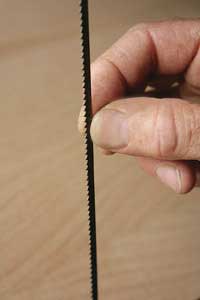
I have a Delta band saw in good condition. A friend is making a violin and came to saw some maple scroll blanks. Cutting straight cuts, everything was fine. As soon as we turned corners, the wood seared and smoked, leaving a black surface. We had to quit using the saw as we didn’t want the char to come through to the surface after carving. Have you any idea what causes this burning? The 1/4″ saw blade was new with fine teeth, and the radii we were cutting were no less than an inch. It didn’t seem like we were binding the saw blade, but it sure wasn’t happy. Any ideas? – Sam Hawkes
Tim Inman: A one-inch radius for a 1/4″ blade is a tight turn. I’m guessing that’s your problem right there. But, I’ve worked a lot of maple, and there is another problem to consider. Maple has a lot of sugar in it, which is why we sometimes refer to the trees as sugar maples. So does cherry. That sugar content is easily burned. The combination of an easily charred wood and tight turns makes for a problem.
One solution would be to use a narrower blade. Try coarser teeth rather than fine ones; you need more cutting action, not more friction. Make relief cuts into the waste before you do the final cut. This will ease the tension on the blade as you make the turns. And I’ll offer this, too: Being very careful, and following all the safety rules, hold a piece of wax such as a candle against the back of the blade on both sides for a second or two to lube the blade just before you make your cuts. You’ll be amazed at how this helps in a tight curve. Not too much—apply the wax “little and often” as the old guys say.
Rob Johnstone: As Scotty was fond of telling Captain Kirk, “You can’t change the laws of physics!” A 1″ radius is as small as you want to cut with a 1/4″ band saw blade (according to Mark Duginske’s The New Complete Guide to the Band Saw), so I’m guessing that you were trying to push the envelope a bit. Just step down to a 1/8″ band saw blade and I bet all will be well. With that said, maple is notorious for burning easily, so keep the cut moving steadily and as fast the saw blade can reasonably handle
Chris Marshall: Another option is to make a series of relief cuts and remove the waste in smaller segments rather than one big, charred piece. It takes a little longer but might give you better results — and less sanding! — in the end.





